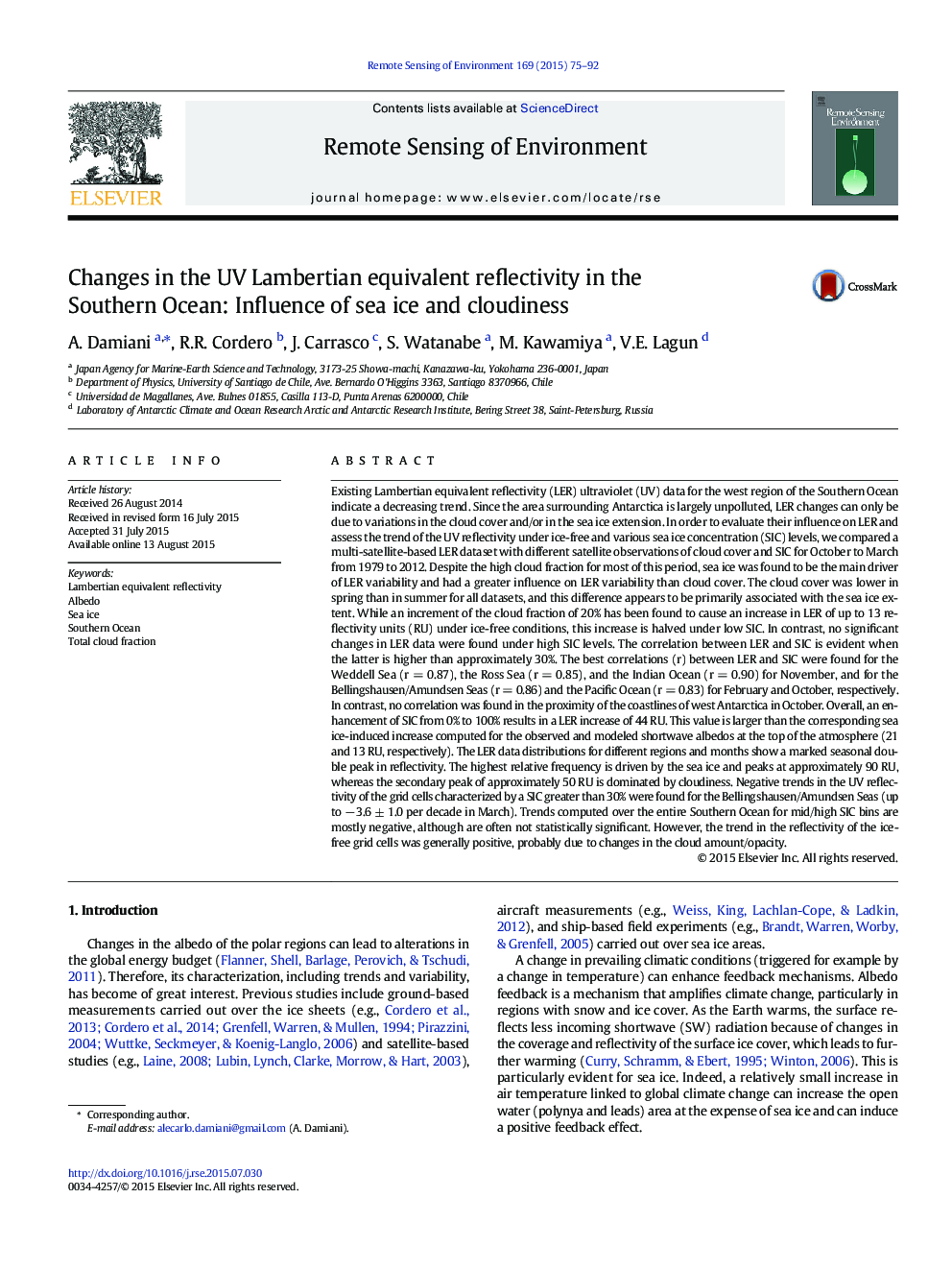| کد مقاله | کد نشریه | سال انتشار | مقاله انگلیسی | نسخه تمام متن |
|---|---|---|---|---|
| 6345798 | 1621231 | 2015 | 18 صفحه PDF | دانلود رایگان |
عنوان انگلیسی مقاله ISI
Changes in the UV Lambertian equivalent reflectivity in the Southern Ocean: Influence of sea ice and cloudiness
دانلود مقاله + سفارش ترجمه
دانلود مقاله ISI انگلیسی
رایگان برای ایرانیان
موضوعات مرتبط
مهندسی و علوم پایه
علوم زمین و سیارات
کامپیوتر در علوم زمین
پیش نمایش صفحه اول مقاله

چکیده انگلیسی
Existing Lambertian equivalent reflectivity (LER) ultraviolet (UV) data for the west region of the Southern Ocean indicate a decreasing trend. Since the area surrounding Antarctica is largely unpolluted, LER changes can only be due to variations in the cloud cover and/or in the sea ice extension. In order to evaluate their influence on LER and assess the trend of the UV reflectivity under ice-free and various sea ice concentration (SIC) levels, we compared a multi-satellite-based LER dataset with different satellite observations of cloud cover and SIC for October to March from 1979 to 2012. Despite the high cloud fraction for most of this period, sea ice was found to be the main driver of LER variability and had a greater influence on LER variability than cloud cover. The cloud cover was lower in spring than in summer for all datasets, and this difference appears to be primarily associated with the sea ice extent. While an increment of the cloud fraction of 20% has been found to cause an increase in LER of up to 13 reflectivity units (RU) under ice-free conditions, this increase is halved under low SIC. In contrast, no significant changes in LER data were found under high SIC levels. The correlation between LER and SIC is evident when the latter is higher than approximately 30%. The best correlations (r) between LER and SIC were found for the Weddell Sea (r = 0.87), the Ross Sea (r = 0.85), and the Indian Ocean (r = 0.90) for November, and for the Bellingshausen/Amundsen Seas (r = 0.86) and the Pacific Ocean (r = 0.83) for February and October, respectively. In contrast, no correlation was found in the proximity of the coastlines of west Antarctica in October. Overall, an enhancement of SIC from 0% to 100% results in a LER increase of 44 RU. This value is larger than the corresponding sea ice-induced increase computed for the observed and modeled shortwave albedos at the top of the atmosphere (21 and 13 RU, respectively). The LER data distributions for different regions and months show a marked seasonal double peak in reflectivity. The highest relative frequency is driven by the sea ice and peaks at approximately 90 RU, whereas the secondary peak of approximately 50 RU is dominated by cloudiness. Negative trends in the UV reflectivity of the grid cells characterized by a SIC greater than 30% were found for the Bellingshausen/Amundsen Seas (up to â 3.6 ± 1.0 per decade in March). Trends computed over the entire Southern Ocean for mid/high SIC bins are mostly negative, although are often not statistically significant. However, the trend in the reflectivity of the ice-free grid cells was generally positive, probably due to changes in the cloud amount/opacity.
ناشر
Database: Elsevier - ScienceDirect (ساینس دایرکت)
Journal: Remote Sensing of Environment - Volume 169, November 2015, Pages 75-92
Journal: Remote Sensing of Environment - Volume 169, November 2015, Pages 75-92
نویسندگان
A. Damiani, R.R. Cordero, J. Carrasco, S. Watanabe, M. Kawamiya, V.E. Lagun,